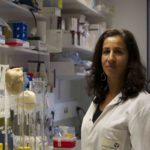Link to HAL – hal-00167551
Link to DOI – 10.1016/j.jsb.2006.04.012
Journal of Structural Biology, 2006, 156 (1), pp.72-83. ⟨10.1016/j.jsb.2006.04.012⟩
Protein degradation by 20S proteasomes in vivo requires ATP hydrolysis by associated hexameric AAA ATPase complexes such as PAN in archaea and the homologous ATPases in the eukaryotic 26S proteasome. This review discusses recent insights into their multistep mechanisms and the roles of ATP. We have focused on the PAN complex, which offers many advantages for mechanistic and structural studies over the more complex 26S proteasome. By single-particle EM, PAN resembles a “top-hat” capping the ends of the 20S proteasome and resembles densities in the base of the 19S regulatory complex. The binding of ATP promotes formation of the PAN-20S complex, which induces opening of a gate for substrate entry into the 20S. PAN’s C-termini, containing a conserved motif, docks into pockets in the 20S’s alpha ring and causes gate opening. Surprisingly, once substrates are unfolded, their translocation into the 20S requires ATP-binding but not hydrolysis and can occur by facilitated diffusion through the ATPase in its ATP-bound form. ATP therefore serves multiple functions in proteolysis and the only step that absolutely requires ATP hydrolysis is the unfolding of globular proteins. The 26S proteasome appears to function by similar mechanisms.


